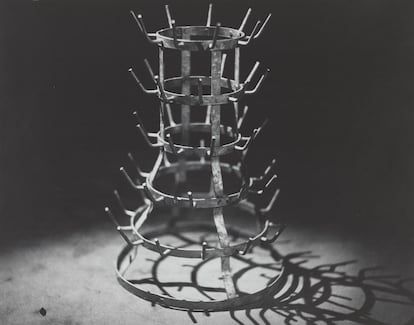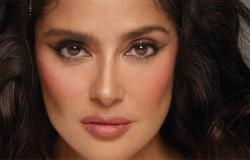In 1922, just over a century ago, Man Ray (Philadelphia, 1890-Paris, 1976) opened his first studio in Paris. There, on the first floor of a modernist building, at 31 bis Rue Campagne-Première, in the heart of Montparnasse, he would manage to elevate his experimental photography to the category of art. Meanwhile, and in parallel, he would portray a whole cast of characters, and without intending to give shape to an elegant typology, which not only offers a record of who’s who of the splendid interwar period, but also a reflection of the extraordinary cultural fabric that illuminated the city on the Seine in the 1920s and 1930s. It was precisely the genre of portraiture, together with fashion photography (he would publish in Vogue, Harper’s Bazaar and Vanity Fair) the driving force behind the fame of the versatile American artist. He had arrived in Paris with the purpose of becoming a painter—an endeavor that he never abandoned—and opted for the camera as a resource to earn a living. He would say that he photographed what “he did not want to paint” and painted what “cannot be photographed”; He thus managed to expand the limits of the photographic medium.
The restless, provocative, mischievous and also somewhat contradictory personality of Emmanuel Rudnitzky (who adopted the name Man Ray at the age of 15, when his family of Russian and Jewish origin moved to New York) would fit perfectly with the Dada spirit. and surrealist, being one of the few photographers associated with both movements. Hence, on the occasion of the centenary of the First surrealist manifestothe Swiss institution, Photo Elysée exhibit Man Ray. Liberating Photography. A journey through the creative work of one of the most emblematic figures in the artistic field of the last 20th century, whose work continues to lengthen its shadow, focused on the 1920s and 1930s. Decades during which the artist would reinvent and open new paths for photography, playing a key role in presenting the photographic medium as an avant-garde vehicle of creative expression.
The exhibition comes from the funds of a private collection: that of the Japanese Tametaka Morinaga, who spent years collecting works by Man Ray with the dream of one day being able to dedicate a museum to him. A wish that he could not fulfill. “I would say that it is the most extensive collection in private hands,” says Nathalie Herschdorfer, curator of the exhibition and director of the museum, during a telephone conversation. Herschdorfer contrasted the images in these funds with those housed in the Pompidou Center (about 12,000 negatives that reflect the author’s prolific nature). “It was interesting to see the variants of poses from the same session,” highlights the curator. “It is known that Man Ray frequently cropped his images, obtaining a result that was far from the existing negative. He would take an interventionist approach to his work paying close attention to the end result. In the exhibition we show works printed by the author in the 1920s but that decades later he would print again changing the cut. An example would be Naked from behind (solarized) (c. 1930) of which we include a copy vintage from another better known version with another frame. So in some way they are different works.”
“In general terms, his portraits are quite classic, with references to the great painters of history such as Rembrandt or Vermeer in terms of light and shadow and composition,” says Herschdorfer. However, his tendency to play, and to put his models into roles in order to seek emotion, to experiment with framing and different experimental techniques, distanced him from merely descriptive fields. “He used to be much more creative when photographing those he considered his muses: Kiki de Montparnasse, Lee Miller, Meret Oppenheim, (artists in their own right) and the lesser-known Adrienne Fidelin,” highlights the curator. “I used his body in the same way that surrealist painters observed female bodies, as sexual objects, but I would say that these women were very active, that it was not the photographer alone who made the decisions. Importantly, they played an active role in the process. It was a collaboration. They intervened beyond posing and wanting to be photographed. I think they influenced him and his work quite a bit.”
There are several self-portraits included in the exhibition, such as the one taken the day Lee Miller abandoned him with a gun in his hand and a rope around his neck. “Since he arrived in Paris and was introduced by his friends, including Jean Cocteau, to different personalities in French society, he understood the importance of self-promotion,” warns the commissioner. “In that sense he played with his own character to be part of that group that he was photographing. He was not shy, nor quiet. He was where he needed to be. And he wanted to be recognized as an artist not as a photographer, this fell short for him.” “It was his achievement to treat the camera as he treated the brush, as a mere instrument at the service of the mind,” Marcel Duchamp would say of Man Ray. It was the possibilities that photography offered as a conceptual tool that really interested the artist.
© Man Ray 2015 Trust. ADAGAP Paris 2023
It was in the darkroom where, leaving aside the camera, he transformed the photographic medium into a powerful tool of artistic expression. So, shortly after arriving in Paris he would begin to create photograms, a technique practiced since the dawn of the medium – and also by Moholy-Nagy and Christian Schad – to once again show off his capacity for self-promotion by calling them rayograms (ray, like his own name). Likewise, he would make use of solarization (rediscovered, accidentally, by Lee Miller, when he worked as his assistant). Man Ray applied these techniques in a different way than had been done until then, within radically new approaches that he would introduce in the field of portraiture, advertising and fashion.
His experimental desire will lead him to cinema, where the author will give more free rein to his surrealist vein than in his photographic work. Filmin offers these days the opportunity to see Man Ray, the return to reason(2023), an anthology made up of four restored films: I return to the reason (1923), Emak bakia (1926), L’étoile de mer (1928) and Les mystères du château du dé (1929), which could be seen for the first time at the 2023 Cannes Film Festival. Halfway between dream and reality, between consciousness and unconsciousness, the author envelops the viewer in evocative successions of textures and rayograms, shapes and cleverly interspersed moving lights; of cloves, fields of daisies or abstract shapes; of enigmatic ladies who drive cars, as in Emak bakia (translatable from Basque as “leave me alone”) subtitled as Cinépoème, and whose title comes from the villa that was rented in the French Basque country for filming. In L’étoile de mer will recreate a poem by Robert Desnos with Kiki as the protagonist. The reissue of the films includes a soundtrack composed by Jim Jarmusch and Carter Logan and performed by their group SQÜRL.

Could not be missing from the exhibition The enigma of Isidore Ducase (1920), where the author plays with the elusive border between object and image and pays tribute to the French poet alias Count de Lautréamont (the true identity of what is hidden under the military blanket tied with a rope remains a mystery) . Man Ray’s main focus was oriented towards expanding the world of the visible, exploring the depths of internal vision and giving rise to the manifestation of what is not real, the transformation of the identity of objects and the incursion of poetry in reality.
Photography is not an art is the provocative title of an essay published in 1937, three years before leaving occupied France to settle in New York. The writing reviewed the then controversial issue of whether photography should be considered an art. “There’s no point in trying to figure out if it’s an art,” he said. “Art is a thing of the past. We need something else. You have to see how light works. It is the light that creates. I sit in front of my sheet of photographic paper and think.” This article was followed by another, Photography can be art, in which he wrote: “Some of the most complete and satisfying works of art have been produced when their authors had no idea that they were creating a work of art, but were concerned with the expression of an idea.”
Man Ray. Liberating Photography. Photo Elysée. Lausanne. Swiss. Until 8 May.
Man Ray. Liberating Photography. Nathalie Herschdorfer and Wendy Grossman. Thames & Hudson. 224 pages. 59 euros.
Man Ray. The return to reason. (2023). 1h 10m. Filmin.
You can follow Babelia in Facebook and xor sign up here to receive our weekly newsletter.
Subscribe to continue reading
Read without limits
_





